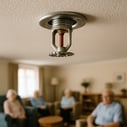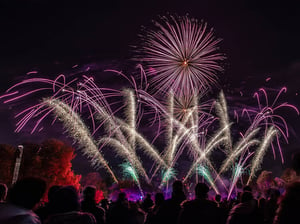New Fire Safety Regulations: What Care Home Providers Need to Know About Mandatory Sprinklers
New fire safety regulations require mandatory sprinklers in new care homes from March 2025 to enhance resident safety and compliance.
Victoria Makepeace
With over 30 years of experience in the health and safety industry, Victoria has built an exceptional track record across both corporate and consultancy roles. She spent her first decade as National Health & Safety Manager for a major pharmaceutical firm, before moving into consultancy, where she has dedicated the past 17 years to advising and supporting diverse clients. Victoria brings a wealth of knowledge, proven leadership, and deep industry insight to every project she undertakes.Date
15 October 2025Updated
16 October 2025
Earlier this year (March 2025), all newly constructed care homes in England are required to have sprinkler systems installed, regardless of building height.
This announcement marks a significant step forward in improving fire safety standards within the care sector. It follows a broader government review of building safety and reflects growing recognition of the particular risks faced by residents in care environments, especially those with mobility issues or cognitive impairments.
Why the Government Has Introduced Mandatory Sprinkler Systems in Care Homes
Care homes accommodate some of society’s most vulnerable individuals, people who may not be able to evacuate quickly or respond effectively to alarms in the event of a fire.
Sprinkler systems are a proven way to contain or extinguish fires before they spread, giving employees valuable time to assist residents safely. The government’s new regulations are a direct response to those concerns, aiming to make fire protection more consistent and effective across all new care facilities.
What the New Fire Regulations Require in Care Homes
The new rules will apply to all new care homes that are being built in England from 2nd March 2025, with the following key requirements:
Sprinklers Must Be Installed in Every New Care HomeAll new builds, regardless of their height, must include a compliant sprinkler system as part of the fire safety design. These systems must meet the standards set out in Approved Document B of the Building Regulations, ensuring correct design, installation, and performance.
Updated Fire Safety Guidance- Approved Document B will also be updated to include specific guidance for care homes. This will cover:
- System design and coverage: ensuring that all key areas are protected.
- Integration with other fire safety measures: sprinklers must work alongside fire alarms, emergency lighting, and evacuation procedures.
- Strong Encouragement to Retrofit Existing Homes
While the legal requirement applies only to new buildings, existing care homes are strongly encouraged to consider retrofitting sprinkler systems, particularly during refurbishments or major upgrades. Even though retrofitting is not yet mandatory, it is an effective way to improve fire safety and may offer long-term cost benefits through reduced insurance premiums and operational risks.
- Transitional Arrangements
Projects that have submitted building-control applications before 2 March 2025 may continue under the previous guidance, provided that construction is sufficiently progressed by 2 September 2025. After that date, all new care homes must comply with the updated sprinkler requirement.
The Benefits of Sprinkler Systems in Care Settings
For care homes, sprinkler systems are not just a regulatory requirement, they are a practical investment in safety and peace of mind.
- Early Fire Suppression
Sprinklers activate automatically when heat is detected, often containing or extinguishing a fire before emergency services arrive.
- Targeted response: Only the sprinkler heads nearest to the fire activate, minimising water damage.
- Round-the-clock protection: Systems operate automatically, even when employees are not immediately present.
- Greater Protection for Residents and Employees
By slowing or stopping the spread of fire and smoke, sprinklers provide employees with vital time to assist residents, particularly those who need support to move. They can also reduce panic and confusion during an emergency situation.
- Reduced Property Damage and Business Disruption
Sprinklers limit damage to the building and its contents, meaning fewer repairs, less disruption, and lower long-term costs.
What The New Fire Regulations Mean for Care Home Providers
Care home operators should now start preparing for these new requirements to ensure compliance and maintain best practice.
- Plan Ahead for New Builds
If you are planning a new care home development:
- Involve fire safety specialists early: Ensure your building design incorporates sprinkler systems from the outset.
- Allow for the cost: While installation adds to construction costs, it is a worthwhile investment that can save lives and reduce future insurance costs.
- Review Fire Safety in Existing Homes
Even if your current facilities are not legally required to have sprinklers, it is important to:
- Review and update your fire risk assessments to ensure they reflect current occupancy, layout, and regulations.
- Consider retrofitting sprinklers during refurbishment projects — this can be a cost-effective way to improve safety and future-proof your facility.
- Stay Up to Date with Regulatory Developments
Fire safety regulations are evolving. Providers should stay informed by:
- Following updates from the National Fire Chiefs Council and the Department for Levelling Up, Housing and Communities (DLUHC).
- Ensuring employees receive regular fire safety training and understand how sprinkler systems fit into wider emergency procedures.
How Should Care Homes Prepare for the New Fire Regulations 2025
To prepare for the introduction of the new regulations:
- Carry Out a Comprehensive Fire Risk Assessment
Identify areas where fire safety could be improved and assess how sprinklers might enhance your existing controls.
- Work with Fire Safety Professionals
Engage consultants with experience in care home environments who can design and install compliant systems.
- Plan for Long-Term Safety Investments
View sprinklers as part of a wider commitment to resident safety — not just a regulatory requirement. The cost of prevention is always far lower than the cost of recovery.
A Positive Step Forward for Care Home Safety
This change represents a major step forward in protecting some of the most vulnerable people in our communities. By ensuring that fires can be controlled quickly and effectively, sprinkler systems will save lives, protect employees, and reduce the long-term impact of fire incidents.
At Neathouse Partners, we can support care home providers in reviewing their current fire safety measures, updating fire risk assessments.
Have questions?
Get in touch today
Contact us, and our team will get back to you within 24 hours. We value your questions and are committed to getting them answered quickly.


Hello! I am Nicky
Just fill in the form below with your details, and I will arrange for a member of our team to give you a call.
By clicking, you agree to our Privacy Policy
Related blog posts

Health & Safety of Firework Displays: What Event Holders Must Know

Why You Should not Rely Solely on ChatGPT or AI Tools to Create Health and Safety Policies

Poor leader knowledge of health & safety is a critical problem for workers
Have questions?
Get in touch today
Contact us, and our team will get back to you within 24 hours. We value your questions and are committed to getting them answered quickly.


Hello! I am Nicky
Just fill in the form below with your details, and I will arrange for a member of our team to give you a call.
By clicking, you agree to our Privacy Policy





